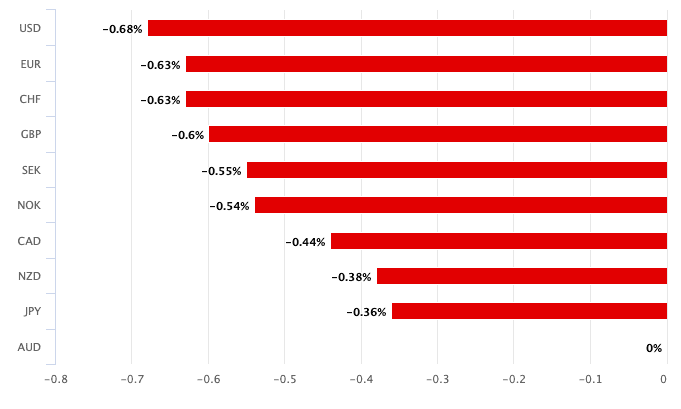Australian Dollar is Down Against All G10 Currencies on Unchanged RBA
- Written by: Gary Howes
-

Above: File image of Governor Philip Lowe. Photo: O'Neill Photographics/Goldman Sachs. Source: RBA on Flickr, reproduced with permission from the RBA press office.
The Australian Dollar is down against the Pound, Dollar, Euro and all G10 peers after the Reserve Bank of Australia (RBA) kept interest rates unchanged.
The central bank said higher interest rates are working to establish a more sustainable balance between supply and demand in the economy and will continue to do so.
In a statement, Governor Philip Lowe said the Reserve Bank Board wanted more time to assess whether the current interest rate stance was the correct one.
The pause was largely expected but the guidance was on the softer side as it gave no clear indication that further interest rate hikes were highly likely, leading to a softer Australian Dollar and Aussie bond yields.
The Pound to Australian Dollar exchange rate advanced to a post RBA-high of 1.9256 on the day, although price action shows strength is confidined to the range of recent days.
The same goes for the Australian Dollar-U.S. Dollar exchange rate which which fell two-thirds of a per cent on the day to trade at 0.6674 but is in touch with recent levels.
More broadly, the currency is lower against all its G10 peers on August 01 following the decision:

Above: AUD performance on August 01.
Screened over a one week timeframe and a one month time frame also reveals the Aussie to be the biggest loser amongst its larger peers.
"AUD fell by 0.6% on a trade weighted basis in July. AUD was mixed against the major currencies. Fading hopes of meaningful Chinese economic stimulus measures were a headwind for AUD later in the month," says Carol Kong, FX Strategist at Commonwealth bank of Australia.
But the RBA's latest decision and guidance added to the softer tone in the Aussie Dollar as domestic interest rates are not higher than those of major peers, denying it 'carry' interest from international investors.
'Carry' is a major driver of FX dynamics in 2023 and describes the process of investors borrowing in low interest rate environments and investing in high interest rate environments to earn a return, in the process boosting demand for the domestic currency.
"We see today's decision as a clear signal that the RBA is taking a wait-and-see approach for the time being," says Esther Reichelt, FX Analyst at Commerzbank. "The RBA appears to be very close to the interest rate peak, especially as it now expects inflation to return to target within its forecast horizon."
The RBA did leave some optionality on the table when it said "some further tightening of monetary policy may be required," leaving the Australian interest rate outlook almost entirely dependent on the tone of incoming data.
"Our expectation remains that the Bank is on an extended pause," says Adam Boyton, Head of Australian Economics at ANZ.
"On the risks around that view we continue to see rate cuts as being a very long way off. If the Bank does move in the near term (or even in the first half of 2024) higher interest rates are much more likely than cuts," he adds.
All eyes now turn to Friday's Statement on Monetary Policy where the RBA will release its latest inflation and economic growth forecasts.






